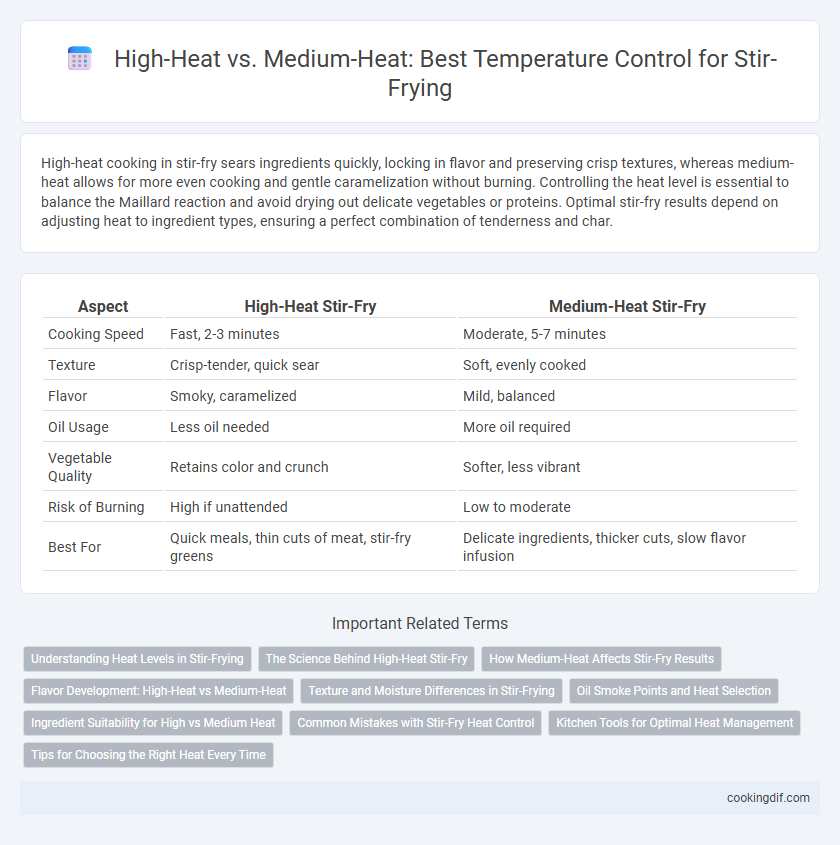High-heat cooking in stir-fry sears ingredients quickly, locking in flavor and preserving crisp textures, whereas medium-heat allows for more even cooking and gentle caramelization without burning. Controlling the heat level is essential to balance the Maillard reaction and avoid drying out delicate vegetables or proteins. Optimal stir-fry results depend on adjusting heat to ingredient types, ensuring a perfect combination of tenderness and char.
Table of Comparison
| Aspect | High-Heat Stir-Fry | Medium-Heat Stir-Fry |
|---|---|---|
| Cooking Speed | Fast, 2-3 minutes | Moderate, 5-7 minutes |
| Texture | Crisp-tender, quick sear | Soft, evenly cooked |
| Flavor | Smoky, caramelized | Mild, balanced |
| Oil Usage | Less oil needed | More oil required |
| Vegetable Quality | Retains color and crunch | Softer, less vibrant |
| Risk of Burning | High if unattended | Low to moderate |
| Best For | Quick meals, thin cuts of meat, stir-fry greens | Delicate ingredients, thicker cuts, slow flavor infusion |
Understanding Heat Levels in Stir-Frying
High-heat stir-frying sears ingredients quickly, locking in flavor and maintaining a crisp texture, especially for vegetables and thinly sliced meats. Medium-heat allows more control over cooking times and prevents burning, making it ideal for delicate proteins and ingredients prone to sticking. Understanding the precise heat needed ensures optimal texture, color, and flavor development in every stir-fry dish.
The Science Behind High-Heat Stir-Fry
High-heat stir-fry cooking triggers the Maillard reaction, creating complex, savory flavors and a desirable browning effect on proteins and vegetables. At temperatures typically above 300degF (150degC), the rapid evaporation of moisture helps maintain crisp textures and prevents sogginess. Controlling heat intensity ensures efficient caramelization without burning, optimizing both taste and texture in stir-fried dishes.
How Medium-Heat Affects Stir-Fry Results
Medium-heat stir-frying allows ingredients to cook more evenly and retain moisture, resulting in tender textures and enhanced natural flavors. This temperature control reduces the risk of burning or overcooking delicate vegetables and proteins while still achieving a slight caramelization. Using medium heat ensures better absorption of sauces, creating a balanced and flavorful dish.
Flavor Development: High-Heat vs Medium-Heat
High-heat stir-frying rapidly sears ingredients, locking in moisture and creating a smoky, caramelized flavor known as the Maillard reaction. Medium-heat cooking allows for more even cooking and deeper integration of spices and sauces, enhancing overall flavor complexity without burning. Balancing heat control is essential for achieving optimal texture and taste in stir-fry dishes.
Texture and Moisture Differences in Stir-Frying
High-heat stir-frying rapidly sears ingredients, preserving their natural moisture while creating a crisp, caramelized exterior that enhances texture contrast. Medium-heat cooking softens vegetables and meats more thoroughly, releasing moisture and resulting in a tender, succulent bite but less crunch. Controlling heat intensity allows for precise manipulation of texture and moisture, essential for achieving the desired balance between crispness and juiciness in stir-fry dishes.
Oil Smoke Points and Heat Selection
Choosing the right heat level for stir-frying depends on the oil's smoke point and desired cooking control; high-heat is ideal for oils like peanut or avocado with smoke points above 400degF, enabling quick searing and crisp textures. Medium-heat suits oils with lower smoke points such as olive or sesame oil, preventing burning and preserving delicate flavors while allowing gradual cooking. Proper heat selection avoids toxic smoke and maintains nutritional value, enhancing both safety and taste in stir-fry dishes.
Ingredient Suitability for High vs Medium Heat
High heat suits dense vegetables like broccoli, bell peppers, and carrots, enhancing their crispness and preserving nutrients through quick cooking. Medium heat is ideal for delicate ingredients such as mushrooms, leafy greens, and tofu, preventing them from burning while allowing flavors to develop gently. Adjusting heat control based on ingredient density optimizes texture and taste in stir-fry dishes.
Common Mistakes with Stir-Fry Heat Control
Using high heat for stir-fry can cause uneven cooking and burnt edges, resulting in a tough texture and loss of flavor. Medium heat often leads to steaming rather than searing, making vegetables soggy and meat less caramelized. Proper stir-fry heat control involves maintaining a consistent temperature that allows quick cooking while preserving crispness and vibrant color.
Kitchen Tools for Optimal Heat Management
Selecting the right kitchen tools, such as cast iron or carbon steel woks, is crucial for maintaining high heat necessary for authentic stir-fry techniques. These materials have excellent heat retention and rapid temperature adjustment, enabling precise control over high and medium heat settings. Utilizing an adjustable gas burner with a high BTU output further ensures consistent heat distribution, preventing temperature fluctuations that can compromise stir-fry texture and flavor.
Tips for Choosing the Right Heat Every Time
Selecting the right heat for stir-fry is crucial for optimal texture and flavor; high heat rapidly seals ingredients, preserving crispness and vibrant colors, while medium heat allows for more controlled cooking, preventing burning and ensuring thorough doneness. Use high heat for quick-cooking vegetables and tender proteins like shrimp or thinly sliced beef, and opt for medium heat when stir-frying denser vegetables or thicker cuts that require additional cooking time. Maintain constant movement of ingredients and adjust heat based on smoke point thresholds of cooking oils to avoid bitterness and achieve a perfectly balanced stir-fry every time.
High-heat vs Medium-heat for stir-fry control Infographic

 cookingdif.com
cookingdif.com